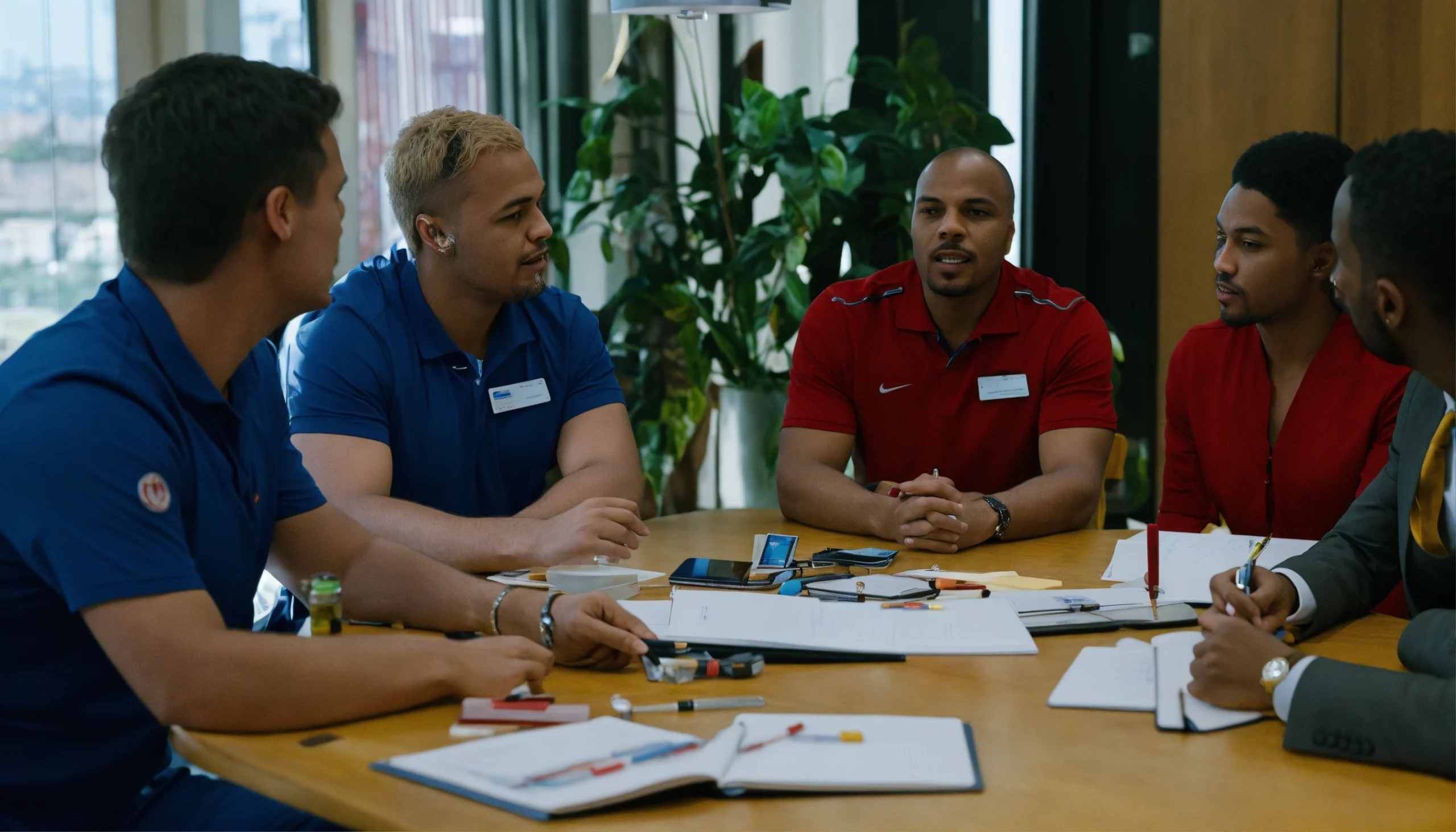Training Tactics
From Good to Great: Training Tactics to Take Your Team to the Next Level

Whether you’re a coach of a sports team, a manager in a company, or a leader in any capacity, you know the importance of taking your team from good to great. Achieving greatness doesn’t happen overnight—it takes dedication, hard work, and effective training tactics to elevate your team to the next level.
So, what are some training tactics that can help your team reach greatness? Here are a few strategies to consider:
1. Set clear goals: One of the first steps in taking your team to the next level is setting clear, achievable goals. These goals should be specific, measurable, attainable, relevant, and time-bound (SMART). By establishing clear objectives, your team will have a roadmap to success and a clear understanding of what is expected of them.
2. Develop a growth mindset: Encourage your team to adopt a growth mindset, which is the belief that abilities can be developed through dedication and hard work. By fostering a growth mindset, your team will be more open to challenges, willing to learn from failures, and motivated to continually improve.
3. Provide ongoing training and development: Investing in your team’s training and development is crucial for taking them to the next level. Whether it’s attending workshops, seminars, or online courses, providing opportunities for skill-building and knowledge acquisition can help your team enhance their capabilities and perform at their best.
4. Foster teamwork and collaboration: Great teams are built on strong relationships, communication, and collaboration. Encourage teamwork by providing opportunities for team members to work together, solve problems collectively, and support one another. When your team works cohesively towards a common goal, they can achieve greatness together.
5. Offer feedback and recognition: Feedback is an essential tool for improvement. Provide constructive feedback to your team members on their performance, highlighting strengths and areas for growth. Additionally, recognize and celebrate their achievements and milestones to boost morale and motivation.
6. Embrace innovation and creativity: Encourage your team to think outside the box, explore new ideas, and innovate. Creativity can lead to breakthroughs and advancements that can propel your team to greater success. Create an environment that values and celebrates innovation to inspire your team to reach new heights.
7. Lead by example: As a leader, you set the tone for your team. Lead by example by demonstrating dedication, perseverance, and a commitment to excellence. Show your team what it means to strive for greatness and inspire them to follow in your footsteps.
Taking your team from good to great requires dedication, hard work, and effective training tactics. By setting clear goals, fostering a growth mindset, providing ongoing training and development, fostering teamwork and collaboration, offering feedback and recognition, embracing innovation and creativity, and leading by example, you can elevate your team to the next level of success. With the right strategies and a team committed to excellence, greatness is within reach.
Training Tactics
Revolutionize Your Training Program with These Game-Changing Tactics

Revolutionize Your Training Program with These Game-Changing Tactics
Training programs are an essential part of any organization’s success. They help employees develop the skills and knowledge they need to perform their job effectively, stay up-to-date on industry trends, and advance in their careers. However, many traditional training programs can be outdated, boring, and ineffective.
To truly revolutionize your training program, you need to incorporate some game-changing tactics that will engage and empower your employees. Here are some innovative approaches you can take to take your training program to the next level:
1. Gamification: One of the most effective ways to make training more engaging and enjoyable is to incorporate elements of gamification. This involves using game-like features such as challenges, rewards, and competition to motivate employees to participate in training activities. By turning training into a fun and interactive experience, you can increase engagement and retention of information.
2. Microlearning: In today’s fast-paced work environment, employees have limited time to dedicate to training. Microlearning breaks down training material into small, bite-sized chunks that are easier to digest and retain. This allows employees to learn at their own pace and fit training into their busy schedules. By delivering content in short, focused modules, you can ensure that employees are more likely to engage with and remember the material.
3. Personalization: Every employee has different learning styles, preferences, and needs. To make your training program more effective, you should personalize the learning experience for each individual. This could involve providing different learning paths based on job roles, offering personalized recommendations for additional training, or allowing employees to choose the topics they want to learn more about. By catering to the individual needs of your employees, you can improve the effectiveness of your training program.
4. Interactive Content: Traditional training programs often rely on passive learning methods such as lectures and presentations. However, interactive content can be much more effective at engaging employees and facilitating learning. Consider incorporating interactive elements such as quizzes, simulations, and role-playing exercises into your training program. By providing hands-on experiences, you can help employees apply what they have learned in a practical and meaningful way.
5. Mobile Learning: With the rise of smartphones and tablets, employees increasingly expect to be able to access training materials on the go. Mobile learning allows employees to learn anytime, anywhere, making it more convenient and accessible. By providing training materials in a mobile-friendly format, you can ensure that employees can engage with the content whenever and wherever it is most convenient for them.
By incorporating these game-changing tactics into your training program, you can revolutionize the way your employees learn and develop. By making training more engaging, personalized, and accessible, you can empower your employees to reach their full potential and drive your organization’s success. Revolutionize your training program today and see the difference it can make in your organization.
Training Tactics
Maximizing Potential: Proven Training Tactics for Employee Development

Employee development is a crucial component of any successful business. By investing in your employees and providing them with opportunities to grow and develop their skills, you not only improve individual performance but also enhance overall team productivity and organizational success.
Maximizing potential begins with effective training tactics that are tailored to each employee’s specific needs and goals. Here are some proven strategies that can help you maximize employee potential through training and development:
1. Personalized Development Plans: One-size-fits-all training programs are often ineffective, as employees have different skills, interests, and aspirations. By creating personalized development plans for each employee, you can ensure that they receive the training and support they need to reach their full potential. Work closely with your employees to identify their strengths, weaknesses, and career goals, and then design a development plan that aligns with their individual needs.
2. Continuous Learning Opportunities: Learning should be an ongoing process, not a one-time event. Provide your employees with opportunities for continuous learning and professional development, such as workshops, seminars, online courses, and on-the-job training. Encourage employees to take ownership of their own development and support them in acquiring new skills and knowledge that are relevant to their roles.
3. Mentoring and Coaching: Pairing employees with experienced mentors or coaches can be a powerful way to accelerate their development. Mentors can provide guidance, support, and feedback to help employees navigate challenges, develop new skills, and achieve their career goals. By investing in mentoring and coaching programs, you can create a culture of learning and growth within your organization.
4. Feedback and Performance Reviews: Regular feedback and performance reviews are essential for helping employees understand their strengths and areas for improvement. Provide constructive feedback that is specific, actionable, and focused on development goals. Encourage employees to reflect on their performance, set new goals, and track their progress over time. By establishing a culture of continuous feedback and development, you can help employees maximize their potential and drive better results for your organization.
5. Skills-based Training: Identify the key skills and competencies that are required for success in each role within your organization, and provide targeted training programs to help employees develop these skills. This could include technical skills, soft skills, leadership skills, or industry-specific knowledge. By focusing on building the skills that are most relevant to each employee’s role, you can help them excel in their current position and prepare for future career advancement.
In conclusion, maximizing employee potential requires a strategic and holistic approach to training and development. By creating personalized development plans, offering continuous learning opportunities, providing mentoring and coaching, giving regular feedback, and focusing on skills-based training, you can empower your employees to reach their full potential and drive success for your organization. Investing in employee development is not only beneficial for individual growth but also for enhancing team performance and organizational competitiveness. By prioritizing training and development, you can create a culture of continuous learning and improvement that positions your business for long-term success.
Training Tactics
Mastering Training Tactics: Strategies for Building a High-Performing Team

Training is an essential component of building a high-performing team. By investing time and resources into developing the skills and capabilities of your team members, you can ensure that they are equipped to meet the challenges of the modern business world. Mastering training tactics is key to unlocking the full potential of your team and driving success for your organization.
One of the most important training tactics is to create a culture of continuous learning within your team. This means encouraging team members to seek out opportunities for skill development and growth, whether through formal training programs, online courses, or on-the-job learning experiences. By fostering a culture of learning, you can ensure that your team stays up-to-date with the latest industry trends and best practices, and is constantly improving their skills and capabilities.
Another key training tactic is to tailor training programs to the specific needs and goals of your team members. One-size-fits-all training programs are unlikely to be effective, as each team member has their own strengths, weaknesses, and areas for development. By customizing training programs to address the individual needs of each team member, you can ensure that they are receiving the support and guidance they need to reach their full potential.
It’s also important to provide opportunities for hands-on learning and practical application of new skills. Simply attending a training program or workshop is not enough – team members need to be able to practice and apply their new skills in real-world situations in order to truly master them. By providing opportunities for on-the-job training and job shadowing, you can ensure that your team members are able to put their new skills into practice and gain valuable experience.
Feedback is another critical component of effective training tactics. Regular feedback helps team members understand their strengths and weaknesses, and provides guidance on how they can improve their performance. By providing constructive feedback in a timely manner, you can help team members identify areas for development and take steps to improve their skills and capabilities.
Finally, it’s important to track and measure the impact of your training programs to ensure that they are effective. By setting clear goals and metrics for training programs, you can assess their impact on team performance and make any necessary adjustments to ensure that they are driving results. By regularly evaluating the effectiveness of your training tactics, you can ensure that your team is constantly improving and growing.
In conclusion, mastering training tactics is essential for building a high-performing team. By creating a culture of continuous learning, tailoring training programs to individual needs, providing hands-on learning opportunities, offering feedback, and measuring the impact of training programs, you can ensure that your team is well-equipped to meet the challenges of the modern business world. Investing in training is an investment in the success of your team and your organization.
